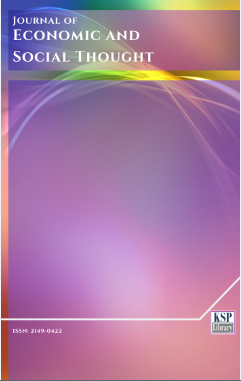On demand-side sources of service innovation ideas
Abstract
Abstract. Increasing degree of consensus has been made among academics and practitioners, that firms should pay special attention to the demand-side factors just to design and produce products/services that gain most loyalty. This article discusses further the specific demand-side sources of service innovation ideas in a multi-layer direct marketing context. Experience marketing, value perception, and re-purchasing process are proposed and articulated. Implications for research and practices are offered.
Keywords. Demand-side drivers, Service innovation, Multi-layer direct marketing.
JEL. M10, M11, M14.
Keywords
References
Agustin, C., & Singh, J. (2005). Curvilinear effects of consumer loyalty determinants in relational exchanges, Journal of Marketing Research, 42(1), 96-108. doi. 10.1509/jmkr.42.1.96.56961
Anderson, E. & Sullivan, M.W. (1993). The antecedents and consequences of customer satisfaction for firms. Marketing Science,12(2), 125-143. doi. 10.1287/mksc.12.2.125
Baker, J., Parasuraman, A., Grewal, D., & Voss, G.B. (2002). The influence of multiple store environment cues on perceived merchandise value and patronage intentions. Journal of Marketing, 66(4), 120-141. doi. 10.1509/jmkg.66.2.120.18470
Bitner, M.J. (1992). Servicescape: The impact of physical surroundings on customers and employees. Journal of Marketing, 56(2), 57-71. doi. 10.2307/1252042
Bolton, R.N. (1997). A dynamic model of the duration of the customer's relationship with a continuous service provider: The role of satisfaction. Marketing Science, 17(1), 45-65. doi. 10.1287/mksc.17.1.45
Bojanic, D.C. (1996). Consumer perceptions of price, value and satisfaction in the hotel industry: An exploratory study. Journal of Hospitality and Leisure Marketing, 14(1), 5-22. doi. 10.1300/J150v04n01_02
Butz, H.E.Jr. & Goodstein, L.D. (1996). Measuring customer value: Gaining the strategic advantage, Organizational Dynamics, 24(4), 63-77. doi. 10.1016/S0090-2616(96)90006-6
Cronin, J.J.Jr., Brady, M.K., & Hult, T.G. (2000). Assessing the effects of quality, value, and customer satisfaction on consumer behavioral intentions in service environments. Journal of Retailing, 76(2), 193-218. doi. 10.1016/S0022-4359(00)00028-2
Dawson, S., Bloch, P.H ., & Ridgway, N.M. (1990). Shopping motives, emotional states, and retail out comes. Journal of Retailing, 66(4), 408-427.
Drucker, P.F. (1986). Innovation and Entrepreneurship: Practice and Principles. Heinemann, London. FreePress.
Drucker, P.F. (1998). Peter Drucker on the Profession of Management, Boston, Mass: Harvard Business School.
Edwardson, M. (2001). Involvement, Self Cconcept and Murdoch Magazines. Case Study In: Consumer Behavior. Sydney: Pearson Publishing.
Flint, D.J., Woodruff, R.B., & Gardial, S.F. (1997). Customer value change in industrial marketing relationships, Industrial Marketing Management, 26(2), 163-175. doi. 10.1016/S0019-8501(96)00112-5
Holbrook, M.B., & Hirschman, E.C. (1982). The experiential aspects of consumption: Consumer fantasies, feelings, and fun. Journal of Consumer Research, 9(2), 132-140. doi. 10.1086/208906
Isen, A.M. (1984). Toward understanding the role of affect in cognition, in R.S. Wyer & T.K. Srull (Eds.). Handbook of Social Sognition, (pp.179-236), Hillsdale, NJ: Erlbaum.
Ittelson, W.H. (1973). Environment Perception and Contemporary Perceptual Theory, Environment and Cognition. New York: Seminar Press.
Oh, M. (1999). Service quality, customer satisfaction, and customer value: A holistic perspective. International Journal of Hospitality Management, 18(1), 67-82. doi. 10.1016/S0278-4319(98)00047-4
Patterson, P.G., & Spreng, R.A. (1997). Modelling the relationship between perceived value, satisfaction and repurchase intentions in a business-to-business, services context: An empirical examination. International Journal of Service Industry Management, 8(5), 414-434. doi. 10.1108/09564239710189835
Parasuraman, A., & Grewal, D. (2000). The impact of technology on the quality–value–loyalty chain: A research agenda. Journal of the Academy of Marketing Science, 28(1), 168-174. doi. 10.1177/0092070300281015
Ravald, A., & Grönroos, C. (1996). The value concept and relationship marketing. European Journal of Marketing, 30(2), 19-30. doi. 10.1108/03090569610106626
Sirdeshemukh, D., Singh, J., & Sabol, B. (2002). Consumer trust, value, and loyalty in relation exchanges. Journal of Marketing, 66(1), 15-37. doi. 10.1509/jmkg.66.1.15.18449
Sweeney, J.G., & Wyber, F. (2002). The role of cognitions and emotion in the music-approach-avoidence behavior relationship. Journal of Service Marketing, 16(1), 51-69. doi. 10.1108/08876040210419415
Tam, J.L.M. (2004). Customer satisfaction, service quality and perceived value: an integrative model, Journal of Marketing Management, 20(7-8), 897-917. doi. 10.1362/0267257041838719
Weerawardena, J. (2003). The role of marketing capability in innovation-based competitive strategy, Journal of Strategy Marketing, 11(1), 15-35. doi. 10.1080/0965254032000096766
Zeithaml, V.A. (1988). Consumer perceptions of price, quality, and value: A means-end model and synthesis of evidence, Journal of Marketing, 52(3), 2-22. doi. 10.2307/1251446
Zeithaml, V.A., & Bitner, M.J. (2000). Service Marketing: Integrating Customer Focus Across the Firm, New York: McGraw- Hall International Edition.
DOI: http://dx.doi.org/10.1453/jest.v4i3.1417
Refbacks
- There are currently no refbacks.
Journal of Economic and Social Thought - J. Econ. Soc. Thoug. - JEST - www.kspjournals.org
ISSN: 2149-0422
Editor: [email protected] Secretarial: [email protected] Istanbul - Turkey.
Copyright © KSP Library




